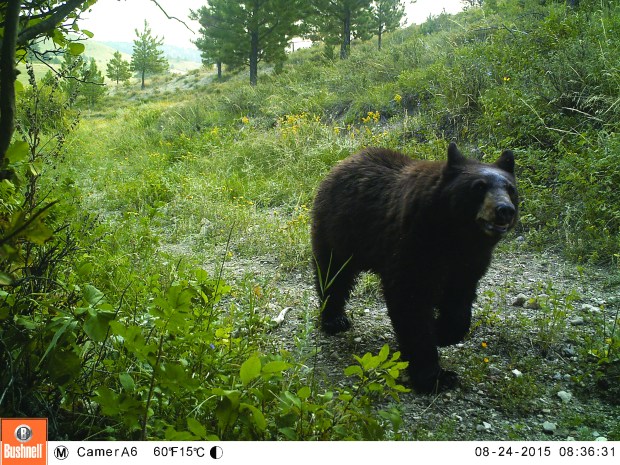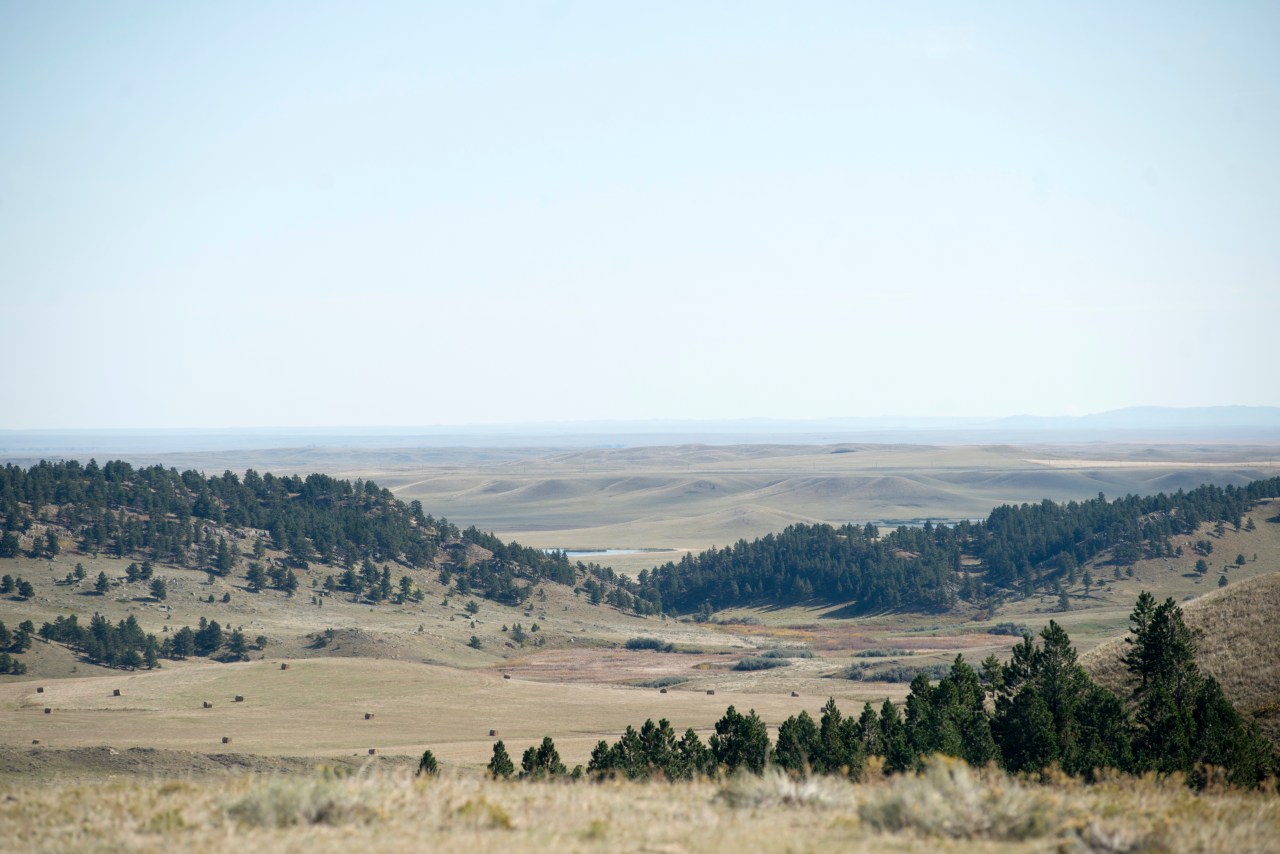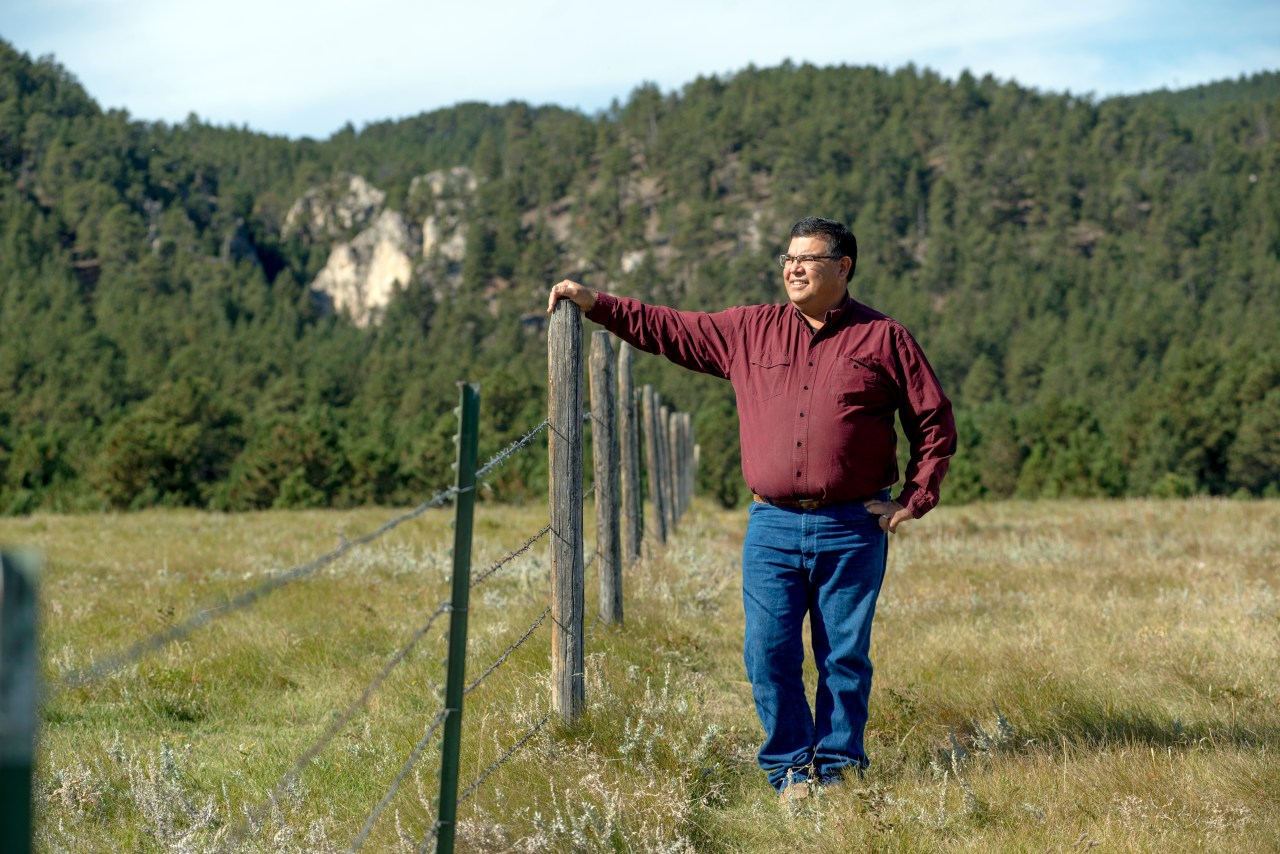The rare black bear creeping through a creek gully on the edge of the Little Rocky Mountains in northeastern Montana had no idea that its picture was silently snapped by a motion-activated camera strapped to a jack pine tree and emailed 270 miles south to the city of Bozeman.
It also didn’t know that the picture was worth $300. Or that the man to whom that check would be cut, barrel-chested cattle rancher Dave Crasco, would be proud enough to parade a printout of the photo around the office of the new beef company he was visiting.
“The bear was exciting,” said Crasco, 49. “I was like, ‘He’s my bear! He’s here because of me.’”
Crasco is a Wild Sky rancher. Wild Sky is a new business based in Bozeman, Montana that pays ranchers like Crasco to allow native wildlife on their private properties. Wild Sky sells a boutique brand of grass-fed beef—higher in protein and lower in fat than corn-fed beef—at a premium price. The extra money is then funneled back to participating ranchers like Crasco on Montana’s Northern Great Plains.
“We’re paying ranchers to welcome wildlife,” said Pete Geddes, who helped found the company. “We’re selling a product with a conservation return.”

Wild Sky is among the latest and most ambitious private efforts to tackle a challenge that has historically fallen to the government—large-scale wildlife conservation. Wild Sky has, since its 2014 inception, helped wildlife flourish across 75,000 additional acres in Montana. That’s an area almost the size of Nevada’s Great Basin National Park. The program works like a terrestrial version of dolphin-safe tuna.
“Now we’re exiting the startup phase,” said Laura Huggins, the CEO of Wild Sky. “We’re projecting 15% growth next year,” from seven ranches to 10.
It was Huggins who gave the bear picture to Crasco. His triumphant march through her office was just one indicator of how Wild Sky has effected change in the year since the two were introduced.
“Back when I first met Laura,” Crasco chuckles over a cup of coffee at his kitchen table, “I was like, ‘You’re my enemy!’”
In the early 2000s a private, nonprofit organization called American Prairie Reserve attempted what the government had tried and failed to do for decades—restore bison to Montana’s Missouri River Country. This was the region where the last huge, wild, and wooly herd of bison in the world lived before they were exterminated in the late 1800s. As Native Americans were forced onto reservations, new settlers cleared the Great Plains of native predators like grizzly bears and wolves that might prey on domestic livestock. They also cleared out native ungulates, like elk and buffalo, that might compete for grass with the introduced cattle.
In the experimental New Deal of the 1930s, President Franklin Delano Roosevelt tried to strike a better ecological balance. He preserved more than a million acres of Northeast Montana for wildlife restoration. Despite decades of talk, however, no wild bison were ever returned.
Fierce opposition from local ranchers and the cattle industry prevented public agencies from bringing back bison. With charity donations, American Prairie Reserve privately purchased cattle ranches from willing sellers on the edge of the wildlife refuge and in 2005 released a small herd of bison bought from South Dakota’s Wind Cave National Park. In short order, three of the four Native American reservations in northern Montana also started their own conservation herds of bison. Today, more of the romantic beasts live on the Great Plains landscape than at any time in the last 140 years. The American Prairie Reserve hopes their open-to-all wildlife refuge will one day stretch across more than three million public and private acres—bigger by half than Yellowstone National Park.
Philanthropic fundraising, however, can only do so much. Cultural opposition remains entrenched. American Prairie Reserve leaders wanted to build better relationships with their neighbors, for whom most of their livelihoods are connected to the cattle industry. But for the idea to start the beef company that became Wild Sky, they looked to the the African country of Namibia.
In Namibia the world’s largest remaining population of cheetahs were being shot on sight by cattle ranchers fearful of predation. In the early 2000s a group called the Cheetah Conservation Fund started a business that sells Namibian beef at premium prices, then sends the profits back to the ranchers in return for their not killing the rare cats. The business has made live cheetahs worth more than dead ones.
“Incentive-based programs are much more widely embraced; communities are more receptive,” said Ryan Lutey, executive director of the U.S. land trust Vital Ground, which since 1990 has compensated ranchers around the northern Rocky Mountains for protecting grizzly bears.

Wild Sky invites ranchers to sign up and choose among a range of actions to help rebounding wildlife. The financial reward increases with each one added. Options include not tilling native sod or poisoning prairie dogs; modifying fences to allow antelope to scurry under and elk to leap over; and simply allowing biologists to install motion-activated cameras. A photo of a mountain lion or a black bear earns the rancher an immediate bonus check of $200 and $300, respectively. That amount will go up if wolves or grizzly bears are photographed migrating back to their ancestral home on the plains, where they were first seen in 1804 by explorers Lewis and Clark.
“I’m really excited by it,” said Arthur Middleton, a wildlife biologist whose innovative maps of elk migrations have been featured in National Geographic Magazine. “Conceptually it makes a lot of sense, I could tell it was thoughtfully developed.”
While still growing and experimenting, Wild Sky now has a waiting list, says CEO Huggins. Each Wild Sky rancher is paid on average a low five-digit sum annually, she says. This helps at a time when beef prices are down but costs of groceries, gas and equipment repairs are not.
“We support producers’ ability to market in the way that best fits their needs and maximizes their profitability,” said Chase Adams, spokesman for the National Cattlemen’s Beef Association.
Crasco, who works a second job as a road repairman, used his check to buy extra hay and fix his diesel pickup, which he’s nicknamed “Brutus.” He says it makes sense to earn extra money for welcoming the wild animals that visit the 1,000-acres of land on which he grazes his Charolais and black angus cattle.
“I’m already living with them,” he says. “If you want to pay me for them, fine—it’s always a fun little bonus.”

The market-based approach to wildlife conservation is not without its critics, however. Many cattle ranchers still philosophically oppose any business that supports such mass-scale wildlife restoration. On the other side, some wildlife advocates warn it risks privatizing public resources.
“You have to be very careful how you incentivize wildlife acceptance,” says activist George Wuerthner, a director at the Foundation for Deep Ecology. “It would be like saying, ‘You’ve got trees and grass on your property that photosynthesize and produce oxygen so we’re going to pay you for that’—I think that would be a bad idea.”
Ethan A. Ligon, a professor of Agricultural & Resource Economics at University of California, Berkeley cautions that tying wildlife incentivization to beef consumption could have built-in inefficiencies, such as “requiring the vegetarian to buy meat at a premium to provide wildlife habitat.”
Jonathan Proctor, a director with Defenders of Wildlife, a conservation group that has worked to incentivize coexistence with wolves, grizzly bears and bison, argues that in some cases a community’s culture can matter more with regard to wildlife than financial reward.
“Money isn’t always the thing that can change somebody’s mind,” he said.
Some in Montana have complained that Wild Sky sources much of its beef outside Montana from other states in the Rocky Mountain and Midwest regions. Huggins explained this is because the national grocery store chains the company signed distribution deals with require a constant supply of meat—more than 50,000 pounds of grass-fed beef per month meeting the same standards of nutritional quality, reduced environmental impact, and taste. For now, Wild Sky is not big enough to meet that demand buying cattle from Montana alone. As it grows and adds more products, like jerky, hot dogs, and ground beef, Huggins said Wild Sky will source more meat from the state where its proceeds go, Montana.
“It’s going to take time to earn people’s trust and respect,” she said.
Money isn’t always the thing that can change somebody’s mind
The landscape already shows signs of Wild Sky’s impact. On Montana’s Fort Belknap Indian Reservation, Hollin Fox’s family gave Wild Sky a try. Like many teens, Fox had spent time shooting prairie dogs—the burrowing rodents that state and federal agencies have poisoned by the millions, because many cattle ranchers consider them pests. Through Wild Sky, Fox learned from wildlife biologists that black-tailed prairie dogs provide crucial food and habitat for rare species ranging from mountain plover birds to swift foxes to endangered black-footed ferrets. Fox began patrolling the prairie dog town on his family’s land to keep them safe.
“They make me proud,” he said by phone, referring to how he felt helping the towns of prairie dogs grow.
Farther south, beneath a rock upthrust called Bald Butte, where Little Warm Creek pours toward the colossal sagebrush blanket of the Great Plains, Crasco threw an arm around his wife, Rawnie, and admired their piece of heaven. A golden eagle swooped over the gully lined with wild plums and chokecherries where the black bear was photographed, and a $300 Wild Sky check was earned.
“They’re keeping their word,” Crasco said. “Just imagine if I get a picture of Bigfoot.”